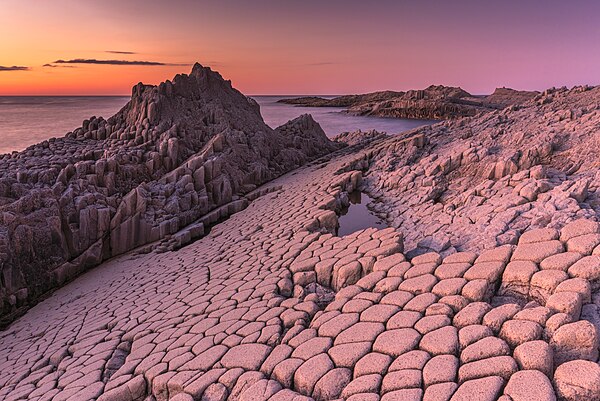 Our 2018 winner comes from Cape Stolbchaty, the cape at east shore of Kunashir Island1 in Sakhalin Oblast, Russia which is famous for its columnar basalt formations. Photo by Ekaterina Vasyagina (www.PhotoJourneys.ru), licensed under CC BY-SA 4.0. “As the sky is all filled with soft amethyst glow, the sunset waves goodbye to stupendously beauteous and resplendent basalt formation of Cape Stolbchaty leaving Vermilion orange sunset”
Our 2018 winner comes from Cape Stolbchaty, the cape at east shore of Kunashir Island1 in Sakhalin Oblast, Russia which is famous for its columnar basalt formations. Photo by Ekaterina Vasyagina (www.PhotoJourneys.ru), licensed under CC BY-SA 4.0. “As the sky is all filled with soft amethyst glow, the sunset waves goodbye to stupendously beauteous and resplendent basalt formation of Cape Stolbchaty leaving Vermilion orange sunset”
From the captivatingly craggy and enthrallingly crafted islands to impeccable reflections, from the dazzling rolling hills to scenic seascapes and from whatever it takes to describe the wizardry mother Earth’s artistry to the mesmerized and romanticized brain, encompasses the photographs that grabbed the positions as Top 10 photographs of Wiki Loves Earth 2018 organized by Wikimedia Affiliates, groups and local Wikipedia volunteers.
Wiki Loves Earth is organized annually with the aim to keep widest variety of protected natural sites possible in the spotlight which will eventually bring people closer to the nature through photography and meaningful captures, and also carries the objective to contribute for environmental protection by raising public awareness.
Thousands of photographs numbered 89,835 in total, uploaded from 32 different countries all over the world comprised Wiki Loves Earth 2018, a photography contest organized worldwide since the year 2014, leaving a remarkable statistic that shows 83% of the total 7,659 uploaders being the new ones.
As in 2016 and 2017, there was a special nomination in collaboration with United Nations Educational, Scientific and Cultural Organization (UNESCO). This year participants were invited to upload photos in a separate category for UNESCO biosphere reserves and UNESCO Global Geoparks across the globe, this year the total uploads reached 3,971 photographs under this category.
Just like the varied range of captures submitted to Wiki Loves Earth every year, the international jury of Wiki Loves Earth 2018 betoken geographic diversity and variety of backgrounds fastened together with their enthusiasm to select the best photographs of natural heritage sites. A perfect mix of personalities from varied professional backgrounds, fond of hobbies that relates to photography, nature or Wikipedia, composes the jury of Wiki Loves Earth 2018: Ananya Mondal (India), Ayokanmi Oyeyemi (Nigeria), Brendan Kenneth Duprey (United States/Eastern Europe), Dietmar Bartz (Germany), Fayçal Rezkallah (Algeria), Fiona Ayerst (South Africa) and Renato Martins (Brazil).
After the thorough assessment are the top 15 prodigious captures that left the jury of Wiki Loves Earth 2018 flabbergasted:
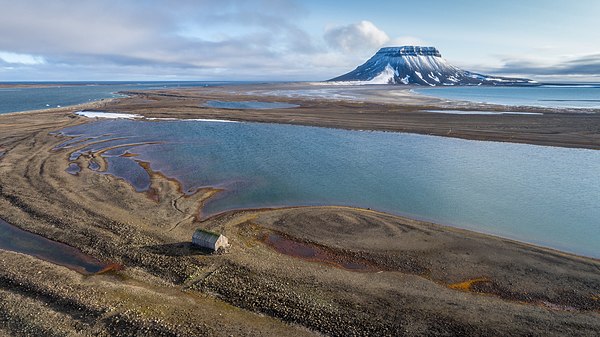 Second place: Bell Island of Franz Josef Land and Eira Lodge of Benjamin Leigh Smith expedition, Russian Arctic National Park. The picture was taken as part of the expedition In the footsteps of two captainsby Maritime Heritage Associations.Photo by Ilya Timin, licensed under CC BY-SA 4.0
Second place: Bell Island of Franz Josef Land and Eira Lodge of Benjamin Leigh Smith expedition, Russian Arctic National Park. The picture was taken as part of the expedition In the footsteps of two captainsby Maritime Heritage Associations.Photo by Ilya Timin, licensed under CC BY-SA 4.0
 Third place: Satchari National Park, Bangladesh. Photo by Abdul Momin, licensed under CC BY-SA 4.0
Third place: Satchari National Park, Bangladesh. Photo by Abdul Momin, licensed under CC BY-SA 4.0
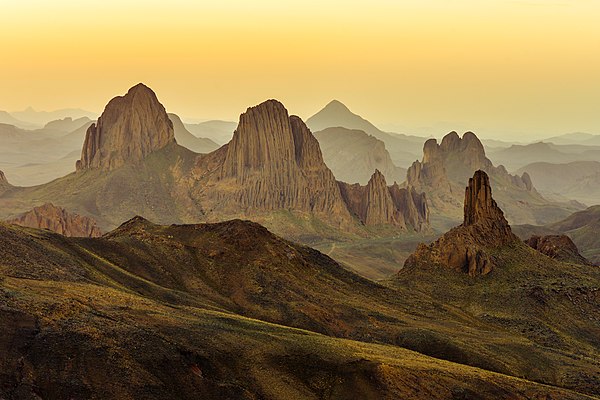 Fourth place: Hoggar National Park, Assekrem, Tamanrasset, Algeria. Photo by Mohammed Amri, licensed under CC BY-SA 4.0
Fourth place: Hoggar National Park, Assekrem, Tamanrasset, Algeria. Photo by Mohammed Amri, licensed under CC BY-SA 4.0
 Fifth place: Autumn at its boom in the valley of Hunza, Gojal Conservancy, Pakistan. Photo by Nasr Rahman, licensed under CC BY-SA 4.0
Fifth place: Autumn at its boom in the valley of Hunza, Gojal Conservancy, Pakistan. Photo by Nasr Rahman, licensed under CC BY-SA 4.0
 Sixth place: Swamp cypress (Taxodium distichum) near Sukko, Krasnodar Krai, Russia. Photo by Aleksandr Horoshilov, licensed under CC BY-SA 4.0
Sixth place: Swamp cypress (Taxodium distichum) near Sukko, Krasnodar Krai, Russia. Photo by Aleksandr Horoshilov, licensed under CC BY-SA 4.0
 Seventh place: Sunset in Baixa Grande, an oasis in the middle of National Park Lençóis Maranhenses. Photo by Brunonogaki, licensed under CC BY-SA 4.0
Seventh place: Sunset in Baixa Grande, an oasis in the middle of National Park Lençóis Maranhenses. Photo by Brunonogaki, licensed under CC BY-SA 4.0
 Eighth place: The wood sandpiper (Tringa glareola) is a small wader at Bangabandhu Sheikh Mujib Safari Park. Photo by Abdul Momin, licensed under CC BY-SA 4.0
Eighth place: The wood sandpiper (Tringa glareola) is a small wader at Bangabandhu Sheikh Mujib Safari Park. Photo by Abdul Momin, licensed under CC BY-SA 4.0
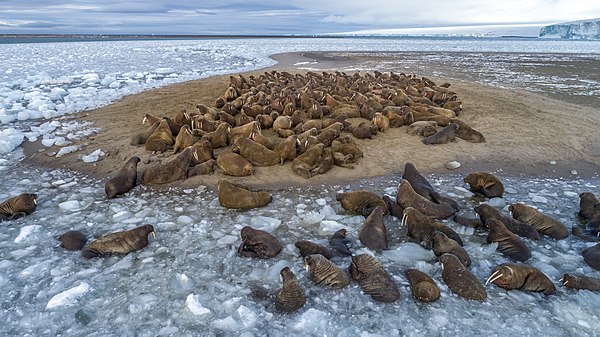 Ninth place: Walruses lying on Northbrook Island. Russian Arctic National Park. The picture was taken as part of the expedition In the footsteps of two captains by Maritime Heritage Associations. Photo by Ilya Timin, licensed under CC BY-SA 4.0
Ninth place: Walruses lying on Northbrook Island. Russian Arctic National Park. The picture was taken as part of the expedition In the footsteps of two captains by Maritime Heritage Associations. Photo by Ilya Timin, licensed under CC BY-SA 4.0
 Tenth place: The shore of Elton Salt Lake, Volgograd Oblast, Russia. Photo by Medvedevphoto (Владимир Медведев), licensed under CC BY-SA 4.0
Tenth place: The shore of Elton Salt Lake, Volgograd Oblast, Russia. Photo by Medvedevphoto (Владимир Медведев), licensed under CC BY-SA 4.0
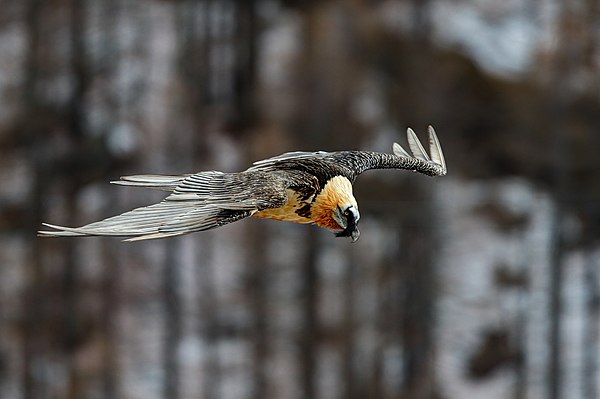 Eleventh place: Gypaetus barbatus in flight. Gran Paradiso National Park, Italy. Photo by Luca Casale, licensed under CC BY-SA 4.0
Eleventh place: Gypaetus barbatus in flight. Gran Paradiso National Park, Italy. Photo by Luca Casale, licensed under CC BY-SA 4.0
 Twelveth place: Chestnut-tailed starling, Satchari National Park, Bangladesh. Photo by Md shahanshah bappy, licensed under CC BY-SA 4.0
Twelveth place: Chestnut-tailed starling, Satchari National Park, Bangladesh. Photo by Md shahanshah bappy, licensed under CC BY-SA 4.0
 Thirteenth place: Phoenicopterus roseus at the lake of Tunis, Tunisia. Photo by El Golli Mohamed, licensed under CC BY-SA 4.0
Thirteenth place: Phoenicopterus roseus at the lake of Tunis, Tunisia. Photo by El Golli Mohamed, licensed under CC BY-SA 4.0
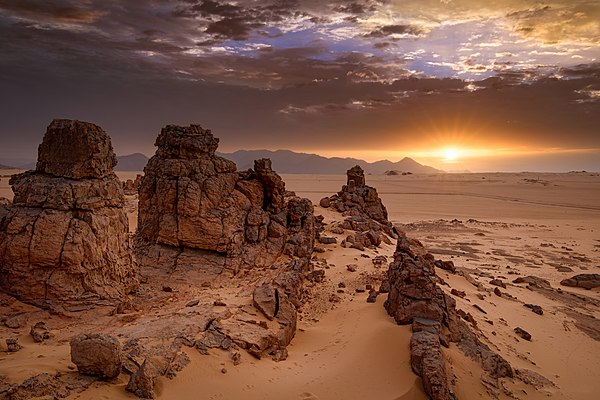 Fourteenth place: Tassili n’Ajjer National Park, Algeria. Photo by Nabil Chettouh, licensed under CC BY-SA 4.0
Fourteenth place: Tassili n’Ajjer National Park, Algeria. Photo by Nabil Chettouh, licensed under CC BY-SA 4.0
 Fifteenth place: Meteora rock formation with monasteries on top of them, Greece. Photo by Stathis Floros, licensed under CC BY-SA 4.0
Fifteenth place: Meteora rock formation with monasteries on top of them, Greece. Photo by Stathis Floros, licensed under CC BY-SA 4.0
The full report of the international jury, explaining the work of the jury, selection process and presenting the results together with comments of the jury, is available here.
Nabin K. Sapkota,
Wiki Loves Earth 2018 International Team


Como faço para enviar algumas fotos que gostei de fotografar?
Quais as regras para tais fotos?
Tem algo não permitido para enviar fotos?
Algumas edições de cores sāo permitidas?
Hi! Please check http://wikilovesearth.org/rules/ & http://wikilovesearth.org/faq/